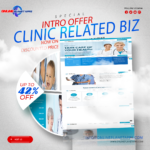A website serves as the virtual storefront and primary touchpoint for businesses seeking to connect with potential customers in the vast online landscape. However, merely having a website is not enough; it must actively engage and attract visitors to fulfill its role as a powerful marketing tool. Let’s explore effective strategies for leveraging a website to reach potential customers and drive business growth.
First and foremost, search engine optimization (SEO) plays a pivotal role in ensuring that a website ranks prominently in search engine results pages (SERPs) when potential customers conduct relevant queries. By optimizing website content, meta descriptions, headers, and URLs with targeted keywords and phrases, businesses can improve their visibility and attract organic traffic from search engines like Google, Bing, and Yahoo. Moreover, creating high-quality, informative content that addresses the needs and interests of the target audience not only enhances SEO but also establishes the website as a credible source of information, thereby attracting and retaining visitors.
In addition to organic search traffic, paid advertising campaigns can effectively drive targeted traffic to a website and reach potential customers with precision. Pay-per-click (PPC) advertising platforms, such as Google Ads and social media advertising networks like Facebook Ads and LinkedIn Ads, allow businesses to create highly targeted ads based on demographic, geographic, and psychographic criteria. By strategically bidding on relevant keywords and demographics, businesses can ensure that their ads appear in front of the right audience at the right time, maximizing the likelihood of conversions and generating a positive return on investment (ROI).
Furthermore, social media platforms offer invaluable opportunities for businesses to reach potential customers and drive traffic to their websites. By establishing a strong presence on popular social media channels such as Facebook, Instagram, Twitter, LinkedIn, and Pinterest, businesses can engage with their target audience, share valuable content, and promote their products or services effectively. Utilizing features like hashtags, geotags, and influencer partnerships can amplify the reach of social media posts and attract followers who may be interested in visiting the website for more information or making a purchase.
Moreover, email marketing remains a highly effective strategy for reaching potential customers and driving traffic to a website. By building an email list of subscribers who have opted in to receive communications from the business, businesses can nurture relationships, deliver targeted messaging, and promote website content, products, or special offers directly to their inbox. Personalizing email content based on customer preferences, behaviors, and past interactions can increase engagement and encourage recipients to click through to the website to learn more or take action.
Additionally, leveraging partnerships and collaborations with complementary businesses, influencers, bloggers, and industry associations can expand the reach of a website and expose it to new audiences. Guest blogging, co-hosting webinars or events, participating in affiliate marketing programs, and sponsoring relevant content or publications can all help increase brand visibility, credibility, and website traffic.
Finally, optimizing the user experience (UX) and ensuring that the website is mobile-friendly, fast-loading, and easy to navigate are essential for retaining visitors and encouraging them to explore further. Clear calls-to-action (CTAs), intuitive navigation menus, and strategically placed contact forms or lead capture mechanisms can guide visitors through the conversion funnel and prompt them to take the desired action, whether it’s making a purchase, requesting more information, or subscribing to updates.
In conclusion, reaching potential customers through a website requires a comprehensive approach that encompasses SEO, paid advertising, social media marketing, email marketing, strategic partnerships, and a focus on delivering exceptional user experiences. By implementing these strategies effectively and continuously monitoring and optimizing performance, businesses can maximize their website’s reach, attract qualified leads, and ultimately drive conversions and revenue growth.






Leave a Reply